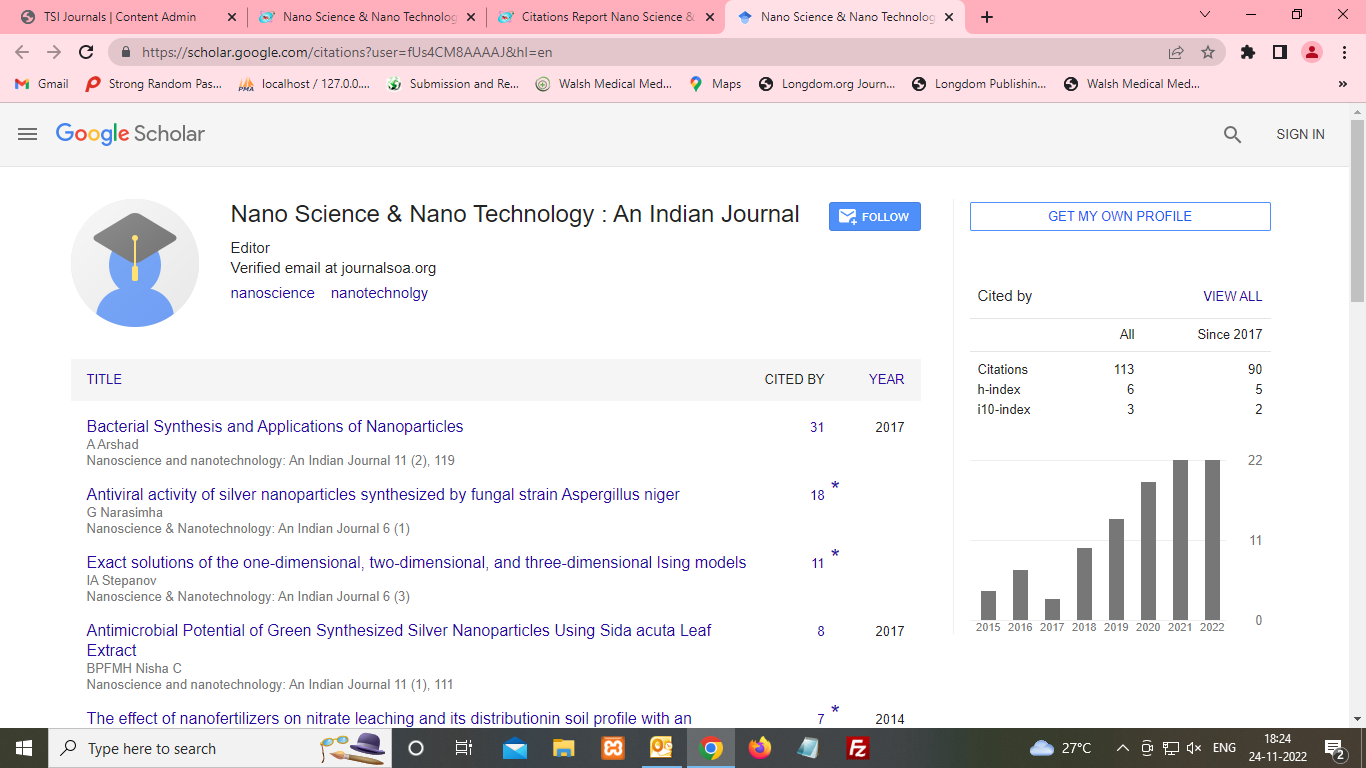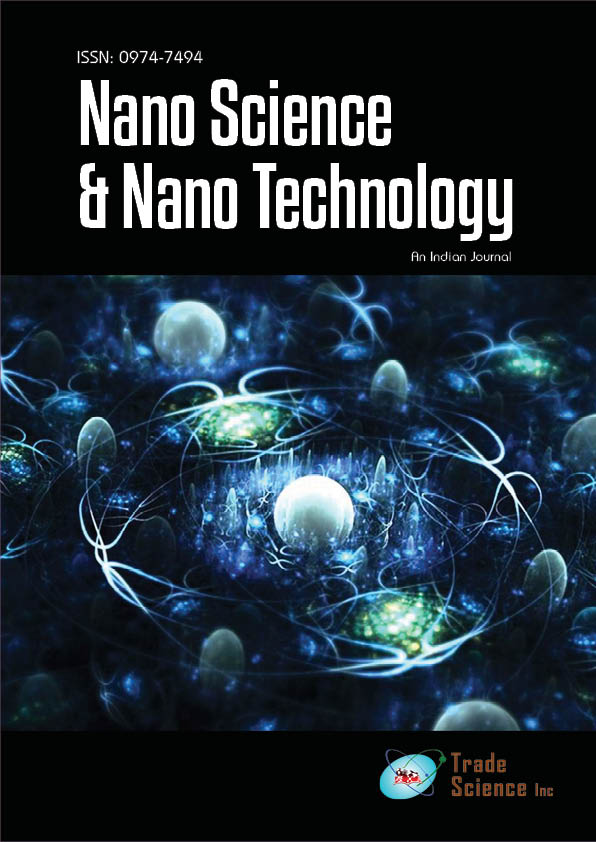Viewpoint
, Volume: 16( 2) DOI: 10.37532/ 0974-7494.2022.16(2).148Nanotechnology's New Applications in Neuroimaging
- *Correspondence:
- Elisa MayEditorial Office, Nanoscience & nanotechnology: An Indian Journal, UK. E-mail: info@tsijournals.com
Citation: May E.. Nanotechnology's New Applications in Neuroimaging. Nano Tech Nano Sci Ind J. 2022; 16(2):148. ©2022 Trade Science Inc.
Abstract
Nanotechnology advances have significant implications for imaging of the central nervous system. Pre- and intra-operative tumor imaging to aid accurate tumor characterization and resection, imaging of therapeutic stem cell delivery and viability in vivo, differentiation of pseudo-progression and pseudo-response in antiangiogenic therapy for glioblastoma multiform, detection of early stages of neurodegeneration, and advances in central nervous system immune-imaging are just a few examples. Animal models, present and upcoming clinical studies, as well as future prospects and consequences for this interesting topic, will be discussed in this review.
Keywords
Celosia; Drought stress; DUF538; Gene expression; Real-Time PCR
Introduction
Nanotechnology advances have significant implications for imaging of the central nervous system. Pre- and intra-operative tumor imaging to aid accurate tumor characterization and resection, imaging of therapeutic stem cell delivery and viability in vivo, differentiation of pseudo-progression and pseudo-response in antiangiogenic therapy for glioblastoma multiform, detection of early stages of neurodegeneration, and advances in central nervous system immune-imaging are just a few examples. Animal models, present and upcoming clinical studies, as well as future prospects and consequences for this interesting topic, will be discussed in this review.
Photoacoustic imaging and gold nano-cages
Gold Nano cages are a new type of optically tunable nanoparticle that has just recently been discovered. These nanoparticles are hollow, extremely porous cube-shaped structures with edge lengths ranging from 30 nm to 200nm. Surface Plasmon resonance peaks can be adjusted for maximum optical absorption in the near-infrared range. Because light attenuation by soft tissue and blood is minimal in this spectrum, it is commonly referred to as the optical window of biologic tissues. The use of gold nanoparticles as optical and photoacoustic imaging contrast agents has been studied extensively. The regulation of surface Plasmon resonance peaks in gold Nano cages has been studied. Photoacoustic tomography imaging is a hybrid imaging technology that combines optical and sonographic imaging modalities and uses sonography to detect absorbed photons.
Antiangiogenic therapy evaluation and validation
Antiangiogenic therapy has a wide range of applications in cancer treatment, with the angiogenesis inhibitor bevacizumab being used to treat recurrent glioblastoma. Angiogenesis imaging is crucial for identifying individuals who would benefit from antiangiogenic medications and monitoring treatment outcomes. There are currently no well-validated radiologic indicators that can be used for these purposes. The "pseudo-response" phenomenon, in which the therapy reduces the permeability of blood vessels, producing the radiologic impression of reduced enhancement on T1-weighted images, which may not indicate a real tumor response, complicates the current evaluation of tumor response through MR imaging.
Nitric oxide detection
Nitric Oxide (NO) synthase produces an inorganic gaseous molecule called nitric oxide from L-arginine. NO has several physiologic activities linked to neurotransmission and neovascularization, and it may play a role in neurotoxicity caused by tissue damage, apoptosis, and ischemia. It is necessary for the production of nitrotyrosine, which has been linked to the advancement of Alzheimer's and Parkinson's diseases. As a result, detecting NO in biological systems is an essential study topic.
Adult neural stem cells might be used in regenerative medicine to treat neurodegenerative, ischemic, and traumatic brain disorders, as well as systemic illnesses like diabetes. Adult neurogenesis is limited to the hippocampus dentate gyrus subgranular zone and the subventricular zone close to the lateral ventricles. Scaffolds, transcription factors, and/or direct stem cell implantation are some of the current strategies for neural regeneration. These stem cell-based therapeutics require noninvasive in vivo imaging to guide therapy and evaluate therapeutic impact in animal models and, eventually, people.
Pericytes are adult multipotent progenitor cells44 that are found in the central nervous system between the inner and most out vascular basement membrane of CNS capillaries and play a role in brain capillary blood flow control, angiogenesis, and bloodbrain barrier maintenance. Using gene transcript–targeted MR imaging contrast agents, noninvasive imaging of brain progenitor cells during angiogenesis was recently shown in a bilateral carotid artery blockage mouse model. SPIO nanoparticles engineered with micro DNA targeting actin and nesting messenger ribonucleic acid (the latter only expressed by pericytes) were given to animals after bilateral carotid artery closure to visualize vascular development by detecting cerebral pericytes in this ischemic brain damage model. Nanospheres and nanocapsules are both polymeric nanoparticles. These are sphere-like biodegradable polymer structures with a payload delivery limited to a central cavity51 or disseminated within a matrix, respectively. By binding to apolipoprotein E, adhesion, and receptor-mediated transcytosis via the low-attenuation lipoprotein receptor found on BBB endothelial cells, nanoparticles made of poly (n-butyl cyanoacrylate) coated with the surfactant polysorbate can cross the BBB.
Nanobodies
Nanobodies are antibodies that were first detected in the serum of the camel Camelus dromedarius. They are made up entirely of heavy chains and have desired properties including compact size, low immunogenicity, and high binding affinities. Nanobodies are used in cancer treatment, antivenoms, inflammatory diseases, and immunoimaging. In vivo, nanobodies can detect vascular and parenchymal amyloid-beta (A) deposits to distinguish between cerebral -amyloid, which is linked with Alzheimer's disease, and vascular A plaques, which are associated with cerebral amyloid angiopathy.
Quantum dots
Quantum dots are nanoparticles with a semiconductor core and a polymer shell that range in size from 10 nm to 20 nm. After that, the polymer shell may be functionalized, allowing any number of physiologically relevant molecules (oligopeptides, antibodies, and so on) to be linked to the surface. Cellular imaging, protein detection, and cancer immunology have all used these functionalized quantum dots. In the next era of customized and targeted medicine, nanotechnology will have a significant influence on medical diagnostics and therapies across many medical disciplines. Stem cell treatment, immune-imaging, and immunotherapy, as well as improved pre-and intraoperative brain tumor identification and targeted payload delivery to the CNS, will likely be affected. Nanobodies are less immunogenic than monoclonal antibodies, are simple to make, and may cross the BBB via their own processes, bringing up new possibilities for CNS immune-imaging and broadening radiologists' participation in molecular-based CNS diagnoses. The capacity to transfer a payload such as a contrast agent or medicine via the BBB with PBCA nanoparticles coated with poly-sorbate 80 is without a doubt an essential and unique aspect of Nano-based applications that opens up a world of possibilities for future CNS therapy and imaging.

